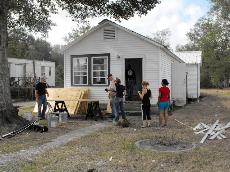We gathered at the Hut on a murky Sunday morning and piled sleepily into two white vans. Fourteen hours later, we had crossed five state lines and watched the city lights of New Orleans sparkle as we passed over before descending into Jean Lafitte, Louisiana. Hello, Fall Break. The work trip had begun.
The group was made up of 20 Guilford students, Guilford staff members Tom Coaxum and Frank Massey, one high school student and 10 members of the North Carolina Friends Disaster Service (FDS).
There were fewer people than on previous trips I’ve been on and that created an interesting dynamic. Because the group was smaller, we got to know each other better and thus had some pretty interesting conversations.
“There were lots of people from different cultures and backgrounds coming together and discussing their differences,” said CCE sophomore Michelle Grisaffi. “It was great having different ages together to accomplish something, to see the two groups come together.”
The trip brought disparate groups together in the pursuit of a common goal: helping people in Jean Lafitte.
Like many places on the Gulf Coast, Lafitte has seen its fair share of flooding and other hurricane damage, particularly in the past few years. The five houses we worked on had all been flooded and were being repaired or rebuilt. “This was the first time that I worked on a house that was already built – painting, doing sheetrock, insulation,” said sophomore Zlatana Nenova. Nenova has been on two other work trips with Guilford and FDS. “This time we worked on so many different things. In Indiana we all worked on the same house, in Kansas we picked a place. Here we worked on four different (sites).” Because the houses were in various stages of repair, we all learned a variety of skills, including basic carpentry, hanging sheetrock, laying subflooring and installing insulation and carpet. “I don’t like putting up the drywall, I don’t like mudding,” said sophomore Jojo Gao. “It just takes a lot of time to even it out. I’m kind of a perfectionist.”
One part Gao did enjoy was playing exterminator in “the pink house,” which had a cockroach problem. “I felt pretty good killing the bugs.”
We learned much more than just skills, however.
“I learned something about constructing houses and about the environment of New Orleans and one of the causes of the flooding,” said Gao.
On Thursday, some of the group took the afternoon off and went on a tour of New Orleans. Guilford graduate Joshua Lewis led us through the devastation in the Ninth Ward. As we looked out over the cypress stumps speckling the Intracoastal Waterway, he discussed the environment of the city and how that interacts with hurricanes.
The changing environment of the Gulf coast also contributes to the severity of hurricane damage. Salt water is creeping into freshwater areas, which is killing off the once-plentiful cypress forests. The trees used to form a sort of barrier against storm surges, and without them, coastline is relatively unprotected.
Another part of what makes the area so vulnerable is its elevation, or lack thereof; the ground is several feet below sea level in many places, with the lowest elevations in the Ninth Ward. Because of this, the levee breaches during Katrina flooded this area the worst.
In reflection of the trip, high school senior Mark Miller felt that more emphasis was placed on certain types of service learning than others.
“I learned more about people, New Orleans and Louisiana than I did about working,” Miller said.
Personally, I enjoy learning from and about people and communities at least as much as learning useful skills like how to put down carpet. Both the conversations I have and the challenges I face make me reevaluate myself and my views.
I struggled with how to deal with the sexist attitudes of some of the FDS men. Between the comments, unequal work distribution and difference in treatment, it was often difficult. However, instead of giving up or changing work sites, I worked harder and it paid off: not only did I feel like I got a lot accomplished, I felt I had earned their respect.
Others had different issues. Some were dissatisfied with the dearth of work, which was in part due to a lack of materials.
“When we were in the ‘shotgun house,’ we didn’t have the materials and spent five hours doing nothing and talking to each other,” Nenova said. “I came here to work.”
Despite these frustrations, most felt that the trip was fun and successful.
“My least favorite part was waking up early,” said junior Katie O’Boyle. “I’m not a morning person, but knowing you’re going to be doing something for other people gets you off of that top bunk bed.


Nicholas Draxton (NickDrax) • Nov 22, 2016 at 2:11 pm
Hey! Wicked cool work people! 🙂 My friend ‘Tamra’ mentioned she’d done this. Hopefully she glances at this some day and decides to actually get back in contact with me!